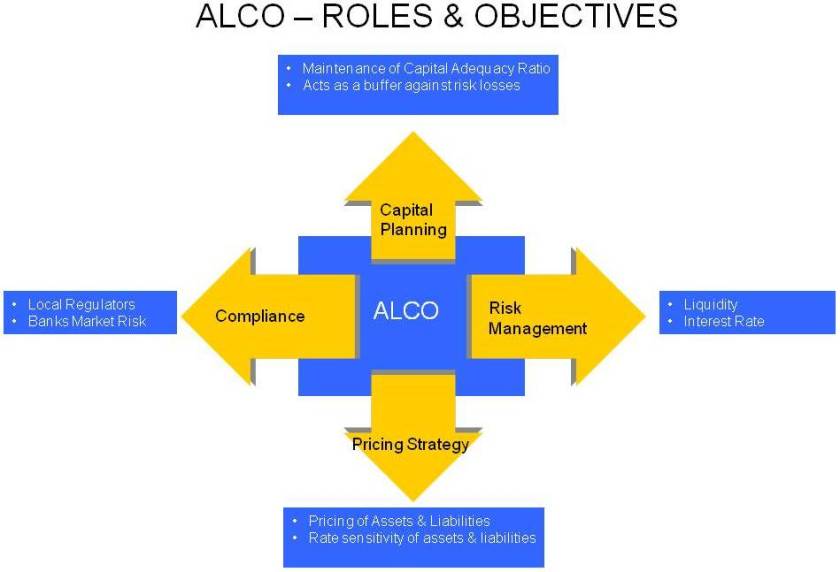Role of ALCO
Banks are required to determine on their own, interest rates on deposits and advances in both domestic and foreign currencies on a dynamic basis. The interest rates on banks’ investments in government and other securities are also market driven. Intense competition for business involving both the assets and liabilities, together with volatility in the interest rates as well as foreign exchange rates, brings pressure on the management of banks to maintain a good balance amongst spreads, profitability and long-term viability. careless liquidity management can put banks’ earnings and reputation at great risk. These pressures call for structured and comprehensive measures and not just one off action.
As banks are exposed to several major risks in the course of their business, it becomes important for banks to manage interest rate, currency and liquidity risks. Banks need to address these risks in a structured manner by Asset-Liability Management (ALM) practices. ALM provides a comprehensive and dynamic framework for measuring, monitoring and managing liquidity, interest rate, foreign exchange and equity risks of a bank that needs to be closely integrated with the banks’ business strategy. It also involves altering the asset-liability portfolio in a dynamic way in order to manage risk.
ALCO is a decision-making unit responsible for balance sheet planning and management from risk-return perspective and also responsible for the strategic management of interest rate and liquidity risks.

Functions of ALCO
The ALCO functions with objectives at a macro level and micro level.
At the macro level, this unit is responsible for:
- Devising critical Business policies.
- Appropriate pricing strategies
At the micro level, it aims at:
- Profitability through Price matching
- Ensuring Liquidity through maturity matching.
The micro level objectives serve the macro level objectives.
Generally the Asset & Liability Committee (ALCO) will ensure that the country balance sheet is managed well according to banks own internal policies and complies with applicable regulatory requirements.
Following are some Specific functions of ALCO:
- To ensure the efficient implementation of balance sheet management policies as directed by GALCO (Group ALCO) and RALCO (Regional ALCO).
- To receive and review reports on liquidity, market risk and capital management.
- To identify balance sheet management issues that are leading to under-performance and refer those that cannot be resolved locally to Regional ALCO.
- To review deposit-pricing strategy for the local market.
- Ensures sustainable funding for the balance sheet.
- Giving directions to the ALM team on the interest rate risk.
ALCO delegates the daily management of liquidity risk and interest rate risk to ALM.
Below is the broad hierarchy of ALCO in a bank

In carrying out its duties, ALCO should pay particular attention to the following points:
Liquidity
- Ensure compliance with banks Group policy and regulatory requirements.
- Set local targets and review assumptions used for forecasting cashflows.
- Review and approve contingency plans for liquidity and realisability assumptions.
- Review and manage concentration risk arising from both borrowers and depositors.
- Ensure business activity is consistent with the structural integrity of the balance sheet, including capital consumption.
- Ensure that risks inherent in local payment systems are evaluated, quantified and managed.
Market Risk
- Review requirements set by external regulators both locally and on a Group basis (bank).
- Establish a rate setting mechanism for all published rates on assets and liabilities with the objective of ensuring that rate risk is effectively transferred to banks treasury units wherever possible.
- Review Price risk profiles of the balance sheet, especially exposures relating to nil rate or administered rate products that give rise to basis risk.
- Review hedging of remittable profits.
Composition of ALCO


The Task of the Asset and Liabilities Committee
Banks derive much of their earnings from the typical spread between short and long term interest rates. By “borrowing short and lending long,” they are able to take advantage of the fact that long term rates typically exceed short-term rates by at least a percentage point or so. However the values of long-term instruments are much more sensitive to interest-rate changes than the value of short-term instruments, setting up a trade-off between the expected return and interest-rate. In practice, evaluating market and liquidity risk involves the consideration of different possible scenarios going forward.
For example:
- What if the bank experiences an unexpectedly large volume of deposit withdrawals?
- What if loan repayments occur faster than anticipated?
- What happens if interest rates suddenly rise by 100 basis points (or one percent)?
The ALCO ’s challenge is to assess the probability that these events will occur and take position to handle the most likely scenarios with a minimum of deterioration in banks performance
More specifically, it is the job of the ALCO to:
- Assess the probability of various liquidity shocks and interest-rate scenarios.
- Position the bank to handle the most likely of these scenarios at minimum cost (impact on earnings and capital) while still achieving a reasonable level of profitability.
- Allocate the bank’s remaining assets and liabilities to meet risk and profitability objectives.
I am sure that after going through this post you would have got a fair idea of what is ALCO and its objectives roles and responsibilities. Please let me know your views.

Hello there, You have done an excellent job. I’ll definitely digg it and in my opinion recommend to my friends. I’m confident they’ll be benefited from this website.|
LikeLike
Hey There. I found your blog using msn. This is a really well written article.
I’ll make sure to bookmark it and return to read more of
your useful information. Thanks for the post. I will certainly return.
LikeLike
I think the admin of this web site is genuinely working hard in support of his website, as here every material is quality based information.
LikeLike